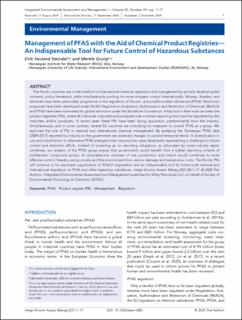| dc.contributor.author | Steindal, Eirik Hovland | |
| dc.contributor.author | Grung, Merete | |
| dc.date.accessioned | 2021-07-14T07:28:54Z | |
| dc.date.available | 2021-07-14T07:28:54Z | |
| dc.date.created | 2021-02-15T16:54:02Z | |
| dc.date.issued | 2020 | |
| dc.identifier.citation | Integrated Environmental Assessment and Management. 2021, 17 (4), 835-851. | en_US |
| dc.identifier.issn | 1551-3777 | |
| dc.identifier.uri | https://hdl.handle.net/11250/2764339 | |
| dc.description.abstract | The Nordic countries are in the forefront of international chemical regulation and management by actively developing the domestic policy framework, while simultaneously pushing for more stringent control internationally. Norway, Sweden, and Denmark have been particularly progressive in the regulation of the per- and polyfluoroalkyl substances (PFAS). Restriction proposals have been developed under the EU Registration, Evaluation, Authorisation and Restriction of Chemicals (REACH) and PFAS have been nominated for global restriction under the Stockholm Convention. A key tool in their work has been the product registries (PRs), where all chemicals imported and produced over a certain reporting limit must be registered by the importers and/or producers. In recent years these PRs have been facing opposition, predominantly from the industry. Simultaneously, and in some contrast, several EU countries are mobilizing for measures to control PFAS as a group. We explored the role of PRs in national and international chemical management. By analyzing the Norwegian PFAS data (2009–2017) reported by industry to the government we observed changes in use and temporal trends. A diversification in use and substitutions to alternative PFAS emerged when new policies were developed, representing a challenge for future control and reduction efforts. Instead of loosening up on reporting obligations, as advocated by some industry representatives, our analysis of the PFAS group argues that governments would benefit from a tighter reporting scheme of problematic compound groups. A comprehensive overview of use, production, and import would contribute to more effective control, thereby saving society and the environment from serious damage and tremendous costs. The Nordic PRs will continue to be important supplements to REACH registration and an indispensable tool for future both national and international regulation on PFAS and other hazardous substances. | en_US |
| dc.language.iso | eng | en_US |
| dc.publisher | Wiley | en_US |
| dc.rights | Attribution-NonCommercial-NoDerivatives 4.0 Internasjonal | * |
| dc.rights.uri | http://creativecommons.org/licenses/by-nc-nd/4.0/deed.no | * |
| dc.title | Management of PFAS with the Aid of Chemical Product Registries — An Indispensable Tool for Future Control of Hazardous Substances | en_US |
| dc.type | Peer reviewed | en_US |
| dc.type | Journal article | en_US |
| dc.description.version | publishedVersion | en_US |
| dc.rights.holder | © 2020 The Authors | en_US |
| dc.source.pagenumber | 835-851 | en_US |
| dc.source.volume | 17 | en_US |
| dc.source.journal | Integrated Environmental Assessment and Management | en_US |
| dc.source.issue | 4 | en_US |
| dc.identifier.doi | https://doi.org/10.1002/ieam.4380 | |
| dc.identifier.cristin | 1890071 | |
| dc.relation.project | Norges forskningsråd: 160016 | en_US |
| cristin.ispublished | true | |
| cristin.fulltext | original | |
| cristin.qualitycode | 1 | |

